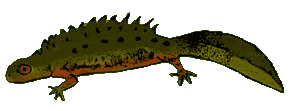|
|
|
|
|
|
Spotlight Species
on

Triturus cristatus
AKA: Great Crested Newt; Warty Newt.
DESCRIPTION / COLORATION: Tadpoles: semi-transparent, feathery gills. Adults: Color is dark green or brown with black splotches and tiny white specks. The belly is yellow or orange with black spots. Males grow an impressive crest during the mating season.
SIZE: This is the largest European newt. Females grow up to 6.5 inches. The males are slightly smaller.
HOME: Central and Northern Europe.
HABITAT: These newts may be found near water in lowlands as well as hilly regions near wooded areas.
LIFESTYLE: Nocturnal. This animal hunts at night in grass and leaf covered areas. It stays hidden during the day in stone or log piles. It is highly active in the summer. It hibernates in the winter. This newt may hibernate in the water or under the ground. They are usually solitary animals, but they often hibernate in groups.
DEFENSES: The great crested newt has poison glands on the skin of its back.
FOOD: Worms, insects, slugs,snails, shellfish, frog eggs, and tadpoles. The great crested newt is known to be cannibalistic. It is also known to eat its own freshly shed skin.
HUNTING TECHNIQUES: This newt relies heavily on its acute sense of smell when hunting both on land and in the water. However when hunting in the water, the newt can additionally use pressure sensitive skin cells located on its head and sides to feel vibrations of potential prey.
BREEDING: Breeding occurs during the spring. The newts will return to the breeding pond from which they hatched. The males will grow crests in order to attract females. Males excrete spermatophores which are taken up be the females via their vents. The females will each lay up to 300 eggs. Each egg will be deposited onto an individual leaf of an underwater plant. Most eggs will hatch after about 3 weeks. The tadpoles will usually grow into their adult form by the end of the summer. Occasionally some tadpoles may remain tadpoles throughout their first winter, maturing during the following spring.
LIFE SPAN: 10 years.
IN CAPTIVITY: Captive newts require an aquarium with water heated to about 68 degrees Fahrenheit and numerous plants. During hibernation, the animal should be kept in a mossy vivarium with the temperature between 35 and 45 degrees Fahrenheit.
SPECIAL CONCERNS: Pollution of water and loss of breeding ponds are of major concern to the great crested newt. Some areas of Europe have laws to protect this species. In these protected areas, the newt populations have been increasing.